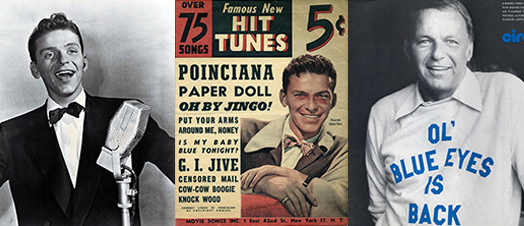Frank Sinatra Centennial
August 2, 2015 – July 3, 2016

Frank Sinatra: The Man, the Voice, and the Fans
Honoring the 100th anniversary of the birth of Hoboken’s most famous native son, the exhibition, “Frank Sinatra: The Man, the Voice, and the Fans,” will open on Sunday, Aug. 2, with a free opening reception from 2 – 5 p.m. The exhibit will feature interactive displays and videos, period-appropriate listening stations, and cherished fan photographs and artifacts to illustrate the singer/actor’s formative years in Hoboken, highlights from his remarkable 60-year career, and memories from legions of fans. The exhibit will be accompanied by packed schedule of singers, films and authors, and a big birthday bash on Dec. 12, 2015.
Sinatra was, as writer Bruce Bliven put it, “a kid from Hoboken who got the breaks.” He emerged from a blue-collar, working class, urban setting, where most guys, he once told an audience, became fighters or worked in factories. His own father, Martin, a recent immigrant from Sicily, started out as a boxer, fighting under the assumed name of Marty O’Brien to gain access to Irish-controlled gyms that wouldn’t admit Italians.
Though he was born in a cold-water flat in a neighborhood of newly arrived immigrants in Southwest Hoboken, his life wasn’t as rough as some biographers have portrayed. He was a rare only child, whose mother, Dolly, used her political savvy and facility with languages to improve her family’s station, securing Marty a position with the city’s fire department. By the time he was 12, the Sinatras had moved to better housing and he earned the derisive nickname of “Slacksy O’Brien” for the dress pants he sported. In the 1920s and 30s, Hoboken was bursting with young singers who performed on street corners, in pool halls and clubs, and in private homes–wherever they could get an audience.
His big break came in 1935, when a Hoboken trio calling themselves the Three Flashes invited him to join them for a shot at the American Idol program of its day, the radio program, “Major Bowes and His Original Amateur Hour.” The Hoboken Four were a hit, and went on a tour sponsored by the radio program for the next several months. Then Sinatra went solo, performing at the Rustic Cabin in Englewood, NJ, which was broadcast on WNEW’s radio program, Dance Parade, leading to an invitation to join the nationally popular Harry James band. In 1939, he joined the Tommy Dorsey band and soon earned the name “Swoonatra,” for causing teenage girls to faint at his concerts.
He would go on to sell more records than any previous singer, and also to pursue a successful Hollywood film career, including an Oscar-winning performance in “From Here to Eternity.” He and his pals in the “Rat Pack” defined the image of American cool in the 1950s and 60s, and he continued to tour and record successful records into his later years. When he died in 1998, fans swarmed Hoboken to mourn the man whose music and movies had meant so much to them.
